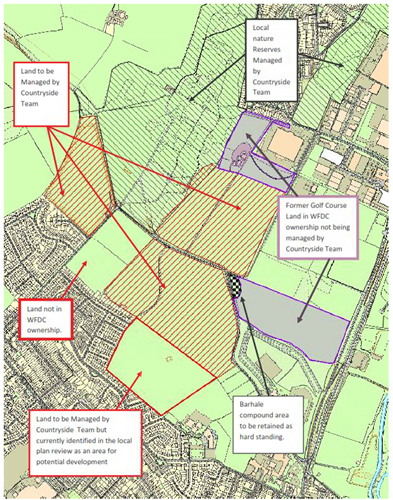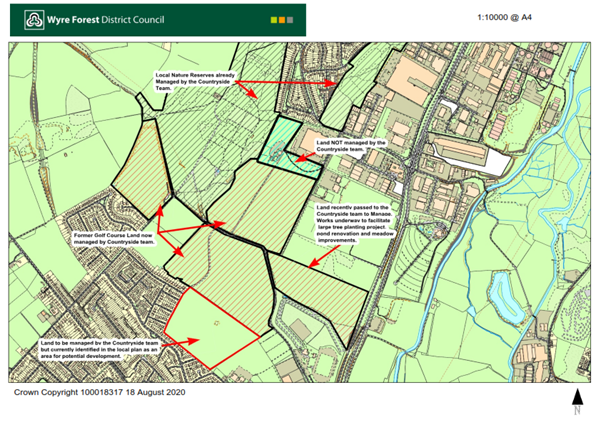Burlish Meadows Conservation Area
Nearest to
Stourport-on-Severn
Parking
Free parking is available all year round.
Opening times
Every day of the year.
Location
Located North of Stourport-on-Severn and South West of Kidderminster.
Main visitor car park and multiple pedestrian access gates located off the Kingsway, Stourport-on-Severn.
Pedestrian access only from A451 Minster Road and Zortech Avenue, Kidderminster
See on Google maps
Map reference
SO 81108 73164
What3Words
look.appeal.rings (Visitor car park entrance)
About
Now available - ![]() Coffee Loco will now be in the main visitor car park Fridays and Saturdays 7am - 2pm. Check out their Facebook page for more information.
Coffee Loco will now be in the main visitor car park Fridays and Saturdays 7am - 2pm. Check out their Facebook page for more information.
A consultation on the development brief for the southern section of the former golf course, currently managed by the Countryside team, but identified in the Wyre Forest Local Plan as site SA.S6 (Abberley Hills View) - an area for potential development is now closed. Officers will review all of the responses received and take them into account before finalising the development brief later this year. Please note that a planning application to develop the site has NOT been received. Please see map below for the different areas of the site. Burlish Meadows will continue to be managed by the Countryside team, including the grazing of cattle and other conservation projects.
Burlish Meadows is approximately 40 hectares in size.
The site links to Burlish Top Local Nature Reserve, Rifle Range Site of Special Scientific Interest and The Devil's Spittleful and Blackstone Farm Fields
The former golf course came under our management in 2018. Over the last few years we have developed the site into an important meadow conservation area. We have cleared extensive flytipping and rubbish from the site; planted native trees; installed vital fencing and gates; created surfaced pathways and installed new ponds.
The Burlish Meadows story so far
 2018 WFDC Countryside service took on the management of two areas of Burlish meadows from its historic land use as a golf course amenity.
2018 WFDC Countryside service took on the management of two areas of Burlish meadows from its historic land use as a golf course amenity.
2019 - through funding we installed fencing on the meadow adjacent to Burlish top for conservation grazing.
2020 – We gained funding through the natural networks grant. We installed two new wildlife ponds and installed a perimeter fence to graze this landscape.
Late 2020 – We gained the a 3rd area of Burlish meadow formerly on old land fill site. We had major operations of clearing out fly tipped waste, litter picking the land with our volunteers, profiling the pond to improve it for aquatic wildlife, and making the site safe for visitors to use.
2021 – In April 2021 we opened our new visitor car park for the old land fill meadow, we also planted trees in this area to enhance the landscape for people and wildlife.
2023 – We planted a further 3,000 trees at Burlish Meadows creating a connecting woodland corridor near to existing planted areas.
2024 - We have been installing new visitor access gates and continuing to improve the Burlish landscape for our visitors to enjoy.
You may have caught Paul Allen our Countryside and Technical Services Manager being interviewed on BBC Midlands Today about the fantastic project at Burlish Meadows. Nature benefitting from Worcestershire golf course transformation - BBC News
Working with Worcestershire Wildlife Trust and their Natural Networks project team our project aims to connect habitats and increase the abundance of wildlife in Worcestershire. Read more about Natural Networks and see the early progression of the project over on Burlish Golf Course - A Natural Networks Case Study | Worcestershire Wildlife Trust (worcswildlifetrust.co.uk)
Creating Habitat – Dead Hedges
The Countryside ranger service have been creating dead hedge habitat around the wildlife pond located on the old landfill meadow at Burlish meadow wildlife site. This will provide a haven for wildlife to shelter and live. The dead hedge will also reduce disturbance from dogs from eroding the banks and trampling the pond vegetation.
Native marginal pondside plants have been planted by our volunteers to provide a food source for our pollinators (insects) and areas to lay eggs.
What is a dead hedge?
In nature branches and other parts of trees teem with life both alive and when dead. To create a dead hedge structure the volunteers have installed rows of hazel stakes along the edge of the area being protected. In-between the stakes the volunteers have filled woody cuttings left over from reserve maintenance to create an upright dead hedge weaving hazel between the stakes to bind it all together.
Benefits of this habitat
Dead hedging is just as beneficial as any living flowering plants and trees we find around meadows, gardens, and other open spaces.
The next step
We will be continually adding additional natural materials into this structure over time including living plants such as honey suckles & wild roses which will provide natural colours and food sources for pollinators. Eventually this denser hedge will provide a home for birds to nest and other creatures such as mammals.










